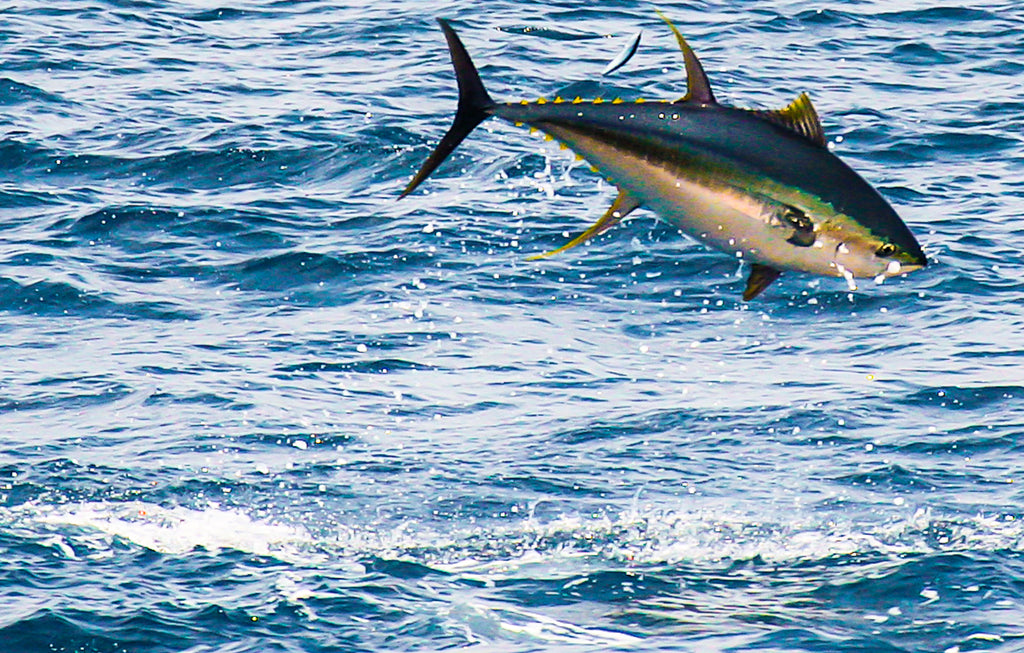
Yellowfin tuna (Thunnus albacares) is a highly migratory species found in tropical and subtropical oceans around the world. This species is highly valued for its meat, which is rich in protein and omega-3 fatty acids, and is consumed in many countries across the globe. In this article, we will take a detailed look at the yellowfin tuna, including its appearance, size, distribution, habitat, diet, fishing, and conservation status.
Appearance
Yellowfin tuna is a streamlined fish with a pointed head and a body that is broader in the middle and tapers to a slender tail. The upper part of the body is a metallic dark blue, while the lower part is silver-white. The body is covered in small, closely spaced scales, and the fins are yellow or tinged with yellow. The dorsal fin is long and extends almost the entire length of the body, while the anal fin is short and positioned close to the tail. The pectoral fins are also long and pointed and are used for steering and maneuvering.

Al McGlashan Photo
Size
Yellowfin tuna is a large species that can grow up to 2.4 meters (7.9 feet) in length and weigh as much as 200 kg (440 lbs). However, most individuals caught for commercial purposes are between 40-60 kg (90-130 lbs). The size of yellowfin tuna varies depending on the location, as well as factors such as food availability and water temperature.
Distribution
Yellowfin tuna is found throughout the tropical and subtropical waters of the Atlantic, Indian, and Pacific Oceans, including the Gulf of Mexico and the Caribbean Sea. The species is known to migrate over long distances, and populations in one area may be genetically distinct from those in another. In the Pacific Ocean, yellowfin tuna is found from Japan to Australia, and from the coast of California to Peru in the eastern Pacific. In the Indian Ocean, it is found from the east coast of Africa to the waters around Indonesia and Australia. In the Atlantic Ocean, yellowfin tuna is found from Newfoundland to Brazil, and from Portugal to the coast of West Africa.

Habitat
Yellowfin tuna is a pelagic species that inhabits the surface and mid-level depths of the ocean. The species is often found in large schools that may be associated with floating debris or under birds. Yellowfin tuna can tolerate a wide range of water temperatures, from 18-30°C (64-86°F), but prefer water temperatures of around 24°C (75°F).
Diet
Yellowfin tuna is an opportunistic feeder that feeds on a variety of prey, including small fish, squid, and crustaceans. The species is known to feed both during the day and at night, and its diet may vary depending on the location and season. Yellowfin tuna is known to be a fast swimmer, which allows it to catch prey more easily.

Carol Lynn Photo
Fishing
Yellowfin tuna is an important commercial fish species, with the majority of global catch coming from the Western and Central Pacific Ocean. The species is caught using a variety of fishing methods, including longline fishing, purse seines, and trolling with baited lines. Longline fishing is the most common method used to catch yellowfin tuna, and involves setting a line with multiple hooks baited with squid or fish, and waiting for the fish to take the bait. Purse seine fishing involves using a large net to encircle a school of fish, which are then lifted onto a fishing vessel. Trolling involves towing baited lines behind a moving vessel.

Some of the best fishing techniques for catching yellowfin tuna include:
Trolling: Trolling is a popular method used for catching yellowfin tuna. This technique involves towing baited lures or baited lines behind a moving boat. Trolling allows fishermen to cover a large area quickly and is effective for targeting surface-feeding yellowfin tuna.
Chunking: Chunking is a technique that involves cutting up pieces of bait fish, such as mackerel or squid, and throwing them overboard to create a scent trail. Yellowfin tuna are attracted to the scent and will follow it to the boat, where they can be caught using live bait or lures.

Al McGlashan Photo
Drift Fishing: Drift fishing involves drifting with the current while presenting live bait or lures to passing fish. This technique can be effective for catching yellowfin tuna that are feeding deeper in the water column.
Jigging: Jigging is a technique that involves dropping a heavy metal jig down to the desired depth and then jerking it up and down to attract fish. This technique can be effective for catching yellowfin tuna that are feeding at mid-depths.
Live Bait Fishing: Live bait fishing involves using live fish, such as small bonito or mackerel, as bait. Live bait is effective for targeting larger yellowfin tuna, as they prefer to feed on larger prey.

Adrian Gray Photo
Chumming: Chumming involves throwing bait, such as chopped up fish, overboard to attract fish to the boat. This technique can be effective for attracting yellowfin tuna to the boat, where they can be caught using live bait or lures.
It is important to note that the effectiveness of each technique may vary depending on the location, season, and size of the yellowfin tuna population. It is always recommended to research and consult with local fishing experts to determine the most effective techniques for catching yellowfin tuna in a particular area. Additionally, it is important to follow local fishing regulations and guidelines to ensure the sustainability of the yellowfin tuna population.
Back to stories